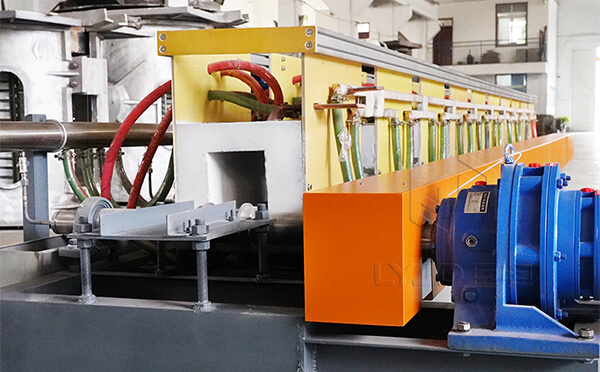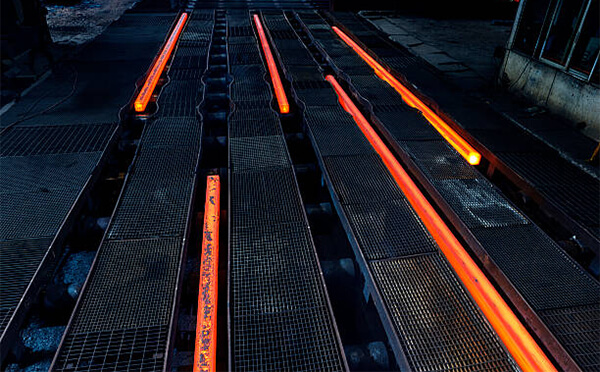As we all know, the billet heating is an important step in the flow of steel rebar rolling mill. But why?
The purpose of billet heating is to improve the plasticity of the billet, which is cast from the continuous casting machine, or bought from the supplier, and reduce the deformation resistance to facilitate rolling. The correct heating process can also eliminate or reduce the internal structural defects of the billet.
The billet heating process is carried out in a three-stage continuous billet heating furnace. The three sections are: preheating section, heating section, and soaking section. The function of the preheating section is to use the waste heat of the heating flue gas to preheat the billet to save fuel. The billet is generally preheated to 300-450℃. The function of the heating section is to heat the pre-heated billet to 1150-1250℃. It is the main heating section of the reheating furnace and determines the heating capacity of the furnace.

Here are the several reasons that why we need to reheat the billets.
Heating the billets prior to rolling is crucial for achieving the desired metallurgical properties of the steel. By uniformly heating the billets, the rolling mill can control the temperature at which the steel is processed. This temperature control is critical for achieving the desired grain structure, mechanical properties, and overall quality of the rebar.
Heating the billets to an elevated temperature increases their plasticity, making them easier to deform during the rolling process. This plasticity enables the reduction of force required to shape the billets into the desired rebar profile. Lowering the force requirements not only improves the efficiency of the rolling mill but also reduces wear and tear on the equipment.
Steel billets often have non-uniform microstructures due to uneven cooling or inconsistencies in the casting process. Heating the billets prior to rolling helps in homogenizing the microstructure by allowing for the redistribution of alloying elements and the elimination of internal stresses. This results in a more consistent product with improved mechanical properties.
During the rolling process, steel undergoes work hardening, which can lead to an increase in its hardness and decrease in its ductility. By heating the billets, the rolling mill can partially reverse the work hardening effect, making the steel more malleable and easier to shape. This helps in maintaining the desired mechanical properties and reducing the likelihood of cracking or other defects during rolling.
Heating the billets to an elevated temperature can help in reducing the overall energy consumption of the rolling mill. The initial heating raises the billets' temperature closer to the desired rolling temperature, reducing the amount of additional energy required during the rolling process itself. This energy-saving aspect is beneficial for both economic and environmental reasons.
While billet heating is important for steel rebar rolling mills, overheating the billets can lead to various defects in the final product. Some of the common defects associated with billet overheating include:

Overheating the billets can cause excessive grain growth, resulting in a coarse grain structure. Coarse grains can negatively impact the mechanical properties of the rebar, reducing its strength, ductility, and toughness. This can compromise the overall quality and performance of the steel.
Overheating can lead to the loss of carbon from the steel surface through a process called decarburization. Decarburization results in a reduced carbon content in the outer layer of the rebar, which can significantly affect its hardness, strength, and wear resistance. This defect can lead to premature failure of the rebar in service.
Overheating the billets can create thermal stresses within the steel, which may result in surface cracking. These cracks can propagate during subsequent rolling operations, leading to surface defects in the rebar. Surface cracks not only compromise the structural integrity of the rebar but also provide initiation points for corrosion, further reducing its service life.
Prolonged overheating can cause internal defects such as internal cracks, voids, and inclusions in the billets. These defects can remain hidden until the rolling process, leading to the production of rebar with internal weaknesses. Such internal defects can significantly reduce the strength, ductility, and fatigue resistance of the rebar, making it susceptible to premature failure.
Excessive heating of the billets can result in dimensional instability during the rolling process. The billets may expand unevenly or experience warping, leading to dimensional inaccuracies in the final rebar product. Dimensional inconsistencies can pose challenges during construction and may require additional processing or sorting to meet the required specifications.
Billet heating plays a critical role in steel rebar rolling mill by enabling temperature control, improving plasticity, homogenizing microstructure, reducing work hardening, and enhancing energy efficiency. These factors collectively contribute to the production of high-quality rebar with the desired mechanical properties.
Please send us your request and we reply to you with in 24 hours.
Submit Request